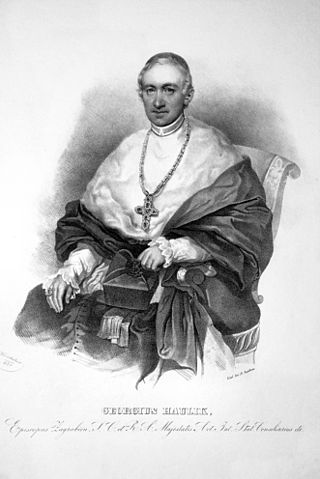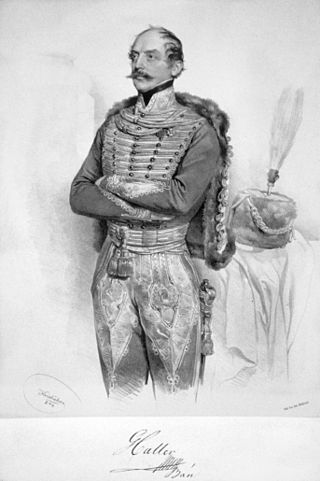At the time of the Roman Empire, the area of modern Croatia comprised two Roman provinces, Pannonia and Dalmatia. After the collapse of the Western Roman Empire in the 5th century, the area was subjugated by the Ostrogoths for 50 years, before being incorporated into the Byzantine Empire.

The Croatian People's Party – Liberal Democrats is a social-liberal political party in Croatia.

The Kingdom of Croatia entered a personal union with the Kingdom of Hungary in 1102, after a period of rule of kings from the Trpimirović and Svetoslavić dynasties and a succession crisis following the death of king Demetrius Zvonimir. With the coronation of King Coloman of Hungary as "King of Croatia and Dalmatia" in 1102 in Biograd, the realm passed to the Árpád dynasty until 1301, when the (male) line of the dynasty died out. Then, kings from the Capetian House of Anjou, who were also cognatic descendants of the Árpád kings, ruled the kingdoms. Later centuries were characterized by conflicts with the Mongols, who sacked Zagreb in 1242, competition with Venice for control over Dalmatian coastal cities, and internal warfare among Croatian nobility. Various individuals emerged during the period, such as Paul I Šubić of Bribir, who was representing the most powerful Croatian dynasty at the time, the Šubić noble family. These powerful individuals were on occasion able to de facto secure great deal of independence for their fiefdoms. The Ottoman incursion into Europe in the 16th century significantly reduced Croatian territories and left the country weak and divided. After the death of Louis II in 1526 during the Battle of Mohács and a brief period of dynastic dispute, both crowns passed to the Austrian House of Habsburg, and the realms became part of the Habsburg monarchy.
This article gives an overview of liberalism in Croatia. Liberals became active since 1860 in Dalmatia and since 1904 in the rest of Croatia. It never became a major political party. It is limited to liberal parties with substantial support, mainly proved by having had a representation in parliament. The sign ⇒ denotes another party in that scheme. For inclusion in this scheme it isn't necessary so that parties labeled themselves as a liberal party.

The Kingdom of Dalmatia was a crown land of the Austrian Empire (1815–1867) and the Cisleithanian half of Austria-Hungary (1867–1918). It encompassed the entirety of the region of Dalmatia, with its capital at Zadar.

The Kingdom of Croatia-Slavonia was a nominally autonomous kingdom and constitutionally defined separate political nation within the Austro-Hungarian Empire. It was created in 1868 by merging the kingdoms of Croatia and Slavonia following the Croatian–Hungarian Settlement of 1868. It was associated with the Kingdom of Hungary within the dual Austro-Hungarian state, being within the Lands of the Crown of St. Stephen, also known as Transleithania. While Croatia had been granted a wide internal autonomy with "national features", in reality, Croatian control over key issues such as tax and military issues was minimal and hampered by Hungary. It was internally officially referred to as the Triune Kingdom of Croatia, Slavonia and Dalmatia, also simply known as the Triune Kingdom, and had claims on Dalmatia, which was administered separately by the Austrian Cisleithania. The city of Rijeka, following a disputed section in the 1868 Settlement known as the Rijeka Addendum, became a corpus separatum and was legally owned by Hungary, but administered by both Croatia and Hungary.

The July victims were members of the Croatian People's Party who fell victim to a crackdown by the Austrian Imperial Army on July 29, 1845.

Ban of Croatia was the title of local rulers or office holders and after 1102, viceroys of Croatia. From the earliest periods of the Croatian state, some provinces were ruled by bans as a ruler's representative (viceroy) and supreme military commander. In the 18th century, Croatian bans eventually became the chief government officials in Croatia.

Juraj Haulik de Váralya was a Croatian cardinal in the Roman Catholic Church of Slovak ethnicity and the first archbishop of Zagreb. He was also acting ban of Croatia for two separate terms.

The Kingdom of Croatia was part of the Lands of the Hungarian Crown, but was subject to direct Imperial Austrian rule for significant periods of time, including its final years. Its capital was Zagreb. It was also a part of the lands of the Habsburg monarchy from 1527, following the Election in Cetin, and the Austrian Empire from 1804 to 1867.

Josip Frank was a Croatian lawyer and politician, a noted representative of the Party of Rights in the Croatian Parliament, and a vocal advocate of Croatian national independence in Austria-Hungary.

The Croatian–Hungarian Settlement was a pact signed in 1868 that governed Croatia's political status in the Hungarian-ruled part of Austria-Hungary. It lasted until the end of World War I, when the Croatian Parliament, as the representative of the historical sovereignty of Croatia, decided on October 29, 1918 to end all state and legal ties with the old Austria-Hungary.
The minister of Croatian affairs of Hungary was a member of the Hungarian cabinet in Austria-Hungary. The position was created following the Croatian–Hungarian Agreement in 1868. The minister was appointed by the emperor-king. The officeholder kept a connection between Croatia-Slavonia-Dalmatia and the Hungarian Kingdom. This position was without portfolio.
People's Party was a political party in the Kingdom of Dalmatia. It was founded in 1861 after the failure of Bach's absolutism, as a branch of the People's Party in Kingdom of Croatia-Slavonia. Its members were known as narodnjaci, aneksionisti or puntari.
Serb People's Party was political party in the Kingdom of Dalmatia during the time of Austria-Hungary.
Croatian-Hungarian Party was the name of a 19th-century political party in the Habsburg Kingdom of Croatia and the Kingdom of Croatia-Slavonia which advocated closer ties between Croatia and Hungary. It was officially named Horvatsko-vugerska stranka in 1841 when it participated in the council of Varaždin County. It was one of the two parties in the 1843 session of the Croatian Parliament. It temporarily ceased to function in 1849, following the Revolutions of 1848; when it was reconstituted in 1860, it was named the Unionist Party, and entered the Parliament in 1861. It was also known as the National Constitutional Party. Because they advocated Magyarization policies, their political adversaries gave them a well-known nickname of mađaroni.

Ferenc Haller, count Haller von Hallerkeö was a Hungarian politician. He served as ban of Croatia-Slavonia between 1842 and 1845 during the Croatian national revival and the Illyrian movement in the 1830s and 1840s.
The Social Democratic Party of Croatia and Slavonia was a social-democratic political party in the Kingdom of Croatia-Slavonia. The party was active from 1894 until 1916.

On 5 December 1918, four days after the proclamation of the Kingdom of Serbs, Croats and Slovenes, the National Guards and Sokol volunteers suppressed a protest and engaged in an armed clash against the soldiers of the 25th Regiment of the Royal Croatian Home Guard and the 53rd Regiment of the former Austro-Hungarian Common Army. National Guardsmen stopped the soldiers at the Ban Jelačić Square in Zagreb.











